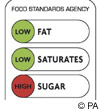 The international trend toward using a simpler “traffic light” nutrient labeling system was discussed here earlier. It tells consumers at a glance if food contains high (red), medium (orange), or low (green) levels of sugar, salt, fat, and saturated fat.
The international trend toward using a simpler “traffic light” nutrient labeling system was discussed here earlier. It tells consumers at a glance if food contains high (red), medium (orange), or low (green) levels of sugar, salt, fat, and saturated fat.
Now, a survey of 200 people in the November issue of the American Journal of Preventive Medicine shows just how much the current system needs to be overhauled.
Say “only” before reading each bullet point.
- 32% of patients correctly calculated the amount of carbohydrates in a 20-ounce bottle of soda that had 2.5 servings in the bottle
- 60% could calculate the number of carbohydrates consumed if they ate half a bagel, when the serving size was a whole bagel
- 22% determined the amount of carbohydrates in 2 slices of low-carb bread
- 23% determined the amount of carbohydrates in a serving of low-carb spaghetti
Holy pasta fasul, Batman!
According to Dr. Russell Rothman, “The study showed that many patients struggle to understand current food labels, and that this can be particularly challenging for patients with poor literacy and numeracy (math) skills.”
Well, I guess.
He continues, “Of particular concern are situations that involve interpretation and application of serving size. There are many opportunities for healthcare providers to improve how they talk to patients about using food labels and following diets. There are also opportunities for the FDA to improve how food labels are designed in order to improve how patients take care of their nutrition.”
I vote for the traffic light system.
9/30/06 15:02 JR